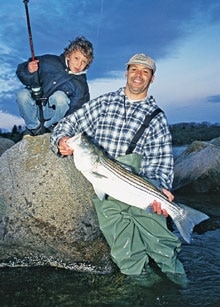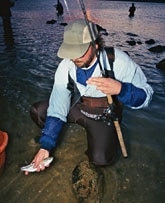
My first introduction to herring came when I was 12 years old. I went fishing in a stream in Westport, Connecticut and came across a school of flat-sided fish that were 12 to 14 inches long, which I caught with small flies. Eight years later I fished the spot where that stream enters Long Island Sound and landed my first 20-pound striper from the surf. From then on, I kept going back to that spot each spring because there was never a shortage of big fish. And while I’d like to say I knew it all along, it didn’t dawn on me till later to make the connection between the herring and big striped bass.
A Time and a Place
|| |—| || |Menemsha Pond in Massachusetts sees an excellent run of herring, which entices striped bass.| Your shot at the herring run starts either in late March or early April once the water temperature hits 40 degrees (see sidebar for herring hot spots). The first action will come on alewives since blueback herring don’t begin spawning for another month or so. Because alewives and bluebacks are anadromous fish, they both move into fresh water to spawn. If you’re lucky you can occasionally stumble across areas where the alewives leave just as the bluebacks arrive.
You can locate good spawning runs via the Internet, local tackle shops and the fisheries management office of the state you plan to fish. In locations where roads cross these waterways, look for signs marking the run and regulations about taking baitfish. Serious anglers log both the arrival and departure of baitfish – usually runs will occur around the same time each season.
You can access most of these spots pretty easily, but getting right to the mouth of the run is sometimes difficult. This is a case in which getting close is usually good enough – reaching the precise source is not essential. Good runs will produce a steady supply of baitfish and provide good fishing to a large area for perhaps a month. The angler who is willing to do the research and walk a bit will find the best fishing.
Dead or Alive

| |Casting whole baits demands relatively stout tackle.| When the time comes to set up your rig, hook live baits through the lips or behind the dorsal fin with a 6/0 to 7/0 bait hook. In areas with a current, an inlet or point, drift the bait down the flow using a free-spooling technique. You can lightly pinch the line between your thumb and forefinger to detect a strike.
If you would rather fish dead bait, you have several rigging options. For a natural swimming action, hook the herring through the lips and work it in the same way you would fish a plug – with slow reel turns and up-and-down movements with your rod tip.
Whole baits weigh eight to nine ounces so you’ll need stout tackle. Your casting motion should resemble a lob instead of a snap. Knowing your casting range is half the battle, so it’s best to select locations like marsh banks, outflows or jetties that put fish within reach. For better distance, hook the bait through the anal fin and either let the bait settle at the bottom or flow in the current. If distance is still an issue, a single hook with a short leader will give you a longer cast. Try a four- to six-ounce sinker and chunk bait fished on the bottom. Also try using the round tail chunks of bait because flat pieces tend to spin in the air when cast.
If you plan on releasing your catch, it’s best to use a single or circle hook to increase the fish’s chance for survival. Keep in mind that stripers usually take a bait head first, so when using cut bait and standard hooks, allow the fish just a short run before setting the hook.
Live Bait Imitators
|| |—| |Where to Go Herring runs take place all along the Atlantic coast. Here a few: *** Chesapeake Bay** The James, York, Rappahannock, Potomac, Susquehanna, Choptank and Nanticoke Rivers. *** The Hudson River** Anywhere from West Point up to the town of Hudson. *** Connecticut** The Housatonic and Connecticut Rivers *** Massachusetts** Cape Cod Canal and Menemsha Pond *** New Hampshire** The Piscataqua River system, including Great and Little Bay. *** Maine** The Kennebec, Sheepscot and Damariscotta Rivers.| Swimming plugs six to eight inches long are effective and give you better casting distance than live bait. To make the plug look more enticing and improve its action, add a single hook to the tail dressed with long bucktail. Surface-swimming plugs with metal lips like the Atom 54 and 40 are effective since you can alter their action by either bending the lip or the front eye. The plug will swim deeper and have better side-to-side action if you bend the eye or the lip upward. To make the plug swim on the surface, bend the eye or the lip down. When the lip and eye are bent down, the plug has a rolling action with less of a wiggle. But popping the rod tip will make it gurgle and splash, simulating a crippled herring swimming along the surface.
For the fly fisherman, this is probably your best shot at landing a big striped bass. Use big, fully dressed herring patterns fished with 350 to 500 grain, Teeny type sinking line. Ten-weight rods or heavier are ideal in these conditions. The best technique is swinging the fly across a flow using a fast retrieve with long pulls. Another approach is to let the fly dead drift and sink, then make quick pulls to cause the fly to turn and nose upward at the edge of a drop-off.
Big rubber baits with jigheads can be very effective if the fish are holding in deeper spots. Let the rig settle and make the lure hop with big pumps of the rod tip. To fish near the surface use a lightweight jighead and make short, quick pulls with the rod tip to simulate a wounded baitfish. Another good combination is a large bucktail jig with a rubber bait for a tail.
This spring, if you want to find big stripers, look for herring. It’s a valuable lesson and may provide you with some of the best action you have ever experienced – no matter how you figure it out.
| Catching Your Bait Catching herring is fairly simple once you find a spawning run, but first you need to make sure it’s legal and know the rules. The two tools you need are a bucket and a small mesh net. In some locations even a trout net will work, but a long handled net is a better choice. Fish ladders and deep pools below dams and spillways are ideal bait collectors when the baitfish are heading upstream. In these deeper pockets, just slide in the net, let the baitfish settle down and scoop up. Shallow locations like drainage pipes or spillways that flow into deeper pools make catching bait easy when they head back to sea. Once the fish enters the pipe heading downstream, just hold your net below the spillway and wait for the fish to swim into it. In major runs getting bait is usually simple so only take what you need. After you’ve found a spot where the herring are running, you’ll want to have a device to keep your bait alive while you fish. One made from a large bucket or cooler attached to a pump will work fine, or a wire cage will do the trick as well if you’re in a spot where you can store it in calm water. – Lou Tabory |









